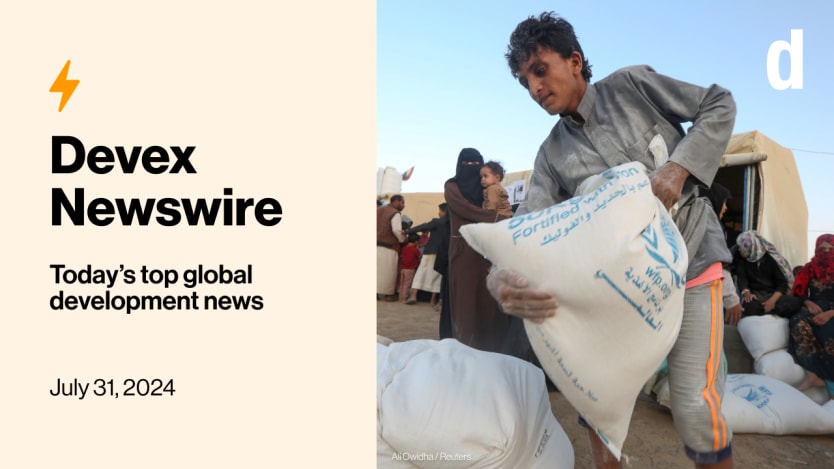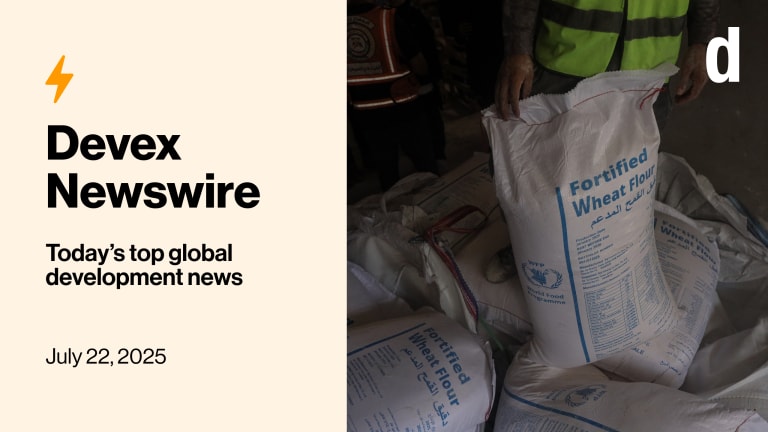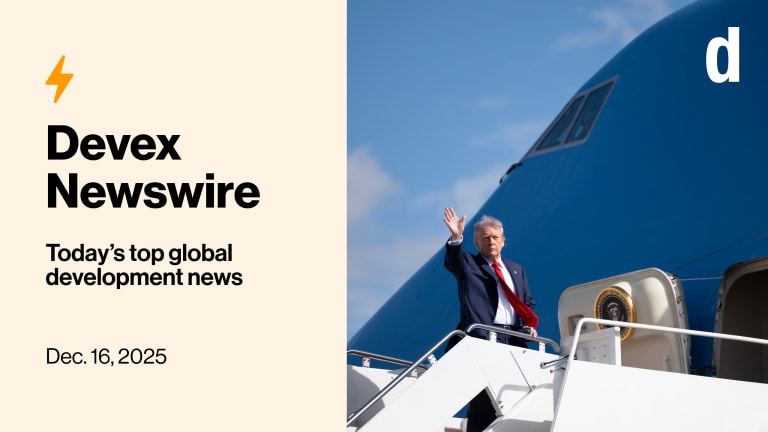
A yearlong freeze on U.S. food aid deliveries to Yemen could be at an end, which would help over 1 million people.
Also in today’s edition: We explain the U.K. Labour Party’s latest aid cuts, and provide practical uses for AI in aid.
+ How well do you remember July’s top headlines? Find out with our monthly news quiz!
Just wheat the doctor ordered
U.S. President Joe Biden's administration has agreed — in principle — to resume wheat deliveries to Houthi-controlled Yemen. The U.S. last year froze delivery of its food aid to northern Yemen, storing a shipment of some 60,000 metric tons in warehouses in the United Arab Emirates.
This is a preview of Newswire
Sign up to this newsletter for an inside look at the biggest stories in global development, in your inbox daily.
The hope back then was to bolster the cash-strapped World Food Programme’s negotiating clout as it struggled to broker a deal that ensured food got to the people who actually needed it.
But now WFP has concluded there has been enough cooperation from the Houthis to justify resuming aid — initially targeting over 1 million people. Of course, that cooperation comes with complications, including Houthi attacks on ships, heightened military tension, and the detention of dozens of diplomats and aid workers. Thirteen detained U.N. workers have even been accused of spying for the U.S. and Israel, the latter of which bombed a Houthi-controlled port on July 20, spurring vows of retaliation from the Houthis.
Those on the ground in Yemen are “terrified,” a source tells Devex Senior Global Reporter Colum Lynch, and the WFP now faces the challenge of ensuring independent monitoring of aid amid Houthi threats. All this could potentially affect aid timelines.
Understandably, within the United Nations there’s criticism of resuming aid without securing worker releases, and due to budget reductions, WFP has had to cut aid to 2.9 million people. But with child malnutrition rates soaring, the U.N. stresses the urgency of resuming aid to prevent worsening conditions.
Exclusive: US to restart aid to Houthi territory
Déjà vu
After years of cuts, Britain’s aid sector may have hoped its new Labour government would be a breath of fresh air. But just weeks after taking power, the new administration has swiftly cut nearly £700 million from its official development assistance, or ODA, to low-income countries.
This reallocation, stemming from the almost £1 billion redirected to cover asylum-seeker housing costs, could mean lean times for multilateral programs and centrally managed projects in particular, Devex U.K. Correspondent Rob Merrick writes.
The prospect has alarmed aid organizations and Sarah Champion, the Labour member of Parliament who chaired the international development committee in the last Parliament. Champion had urged the government to stop raiding the aid budget for what is known as in-donor refugee costs, or IDRC.
Labour, which made preelection promises to restore development aid leadership, now faces backlash for the cuts and for making the international development minister a part-time role. Plans for a new aid model have been shelved, causing further criticism as the government navigates these challenging decisions.
“It is right that we support refugees, but this money should not be at the expense of the poorest in the world. Costs for supporting asylum seekers in the UK needs to come directly from the Treasury, not siphoned off ODA,” Champion tells Devex.
Read: UK Labour makes fresh aid budget cuts within weeks of taking power
ICYMI, download the latest edition of the report: Where does ODA go? (Pro)
Data day
The 2024 Aid Transparency Index has hit record highs, with major aid agencies achieving unprecedented transparency in tracking and sharing their data. Led by Publish What You Fund, this comprehensive assessment analyzed 18,500 data points across 50 agencies, aiming to hold donors accountable and enhance data-driven decision-making.
Key highlights include the African Development Bank retaining its top spot with a score of 98.8, and the United Kingdom’s work jumping from 16th place to 10th in the index from 2022 to today.
The U.S. Millennium Challenge Corporation led U.S. agencies with a score of 93, while the Department of Health and Human Services lagged significantly. The index also noted substantial cuts in aid transparency from Spain and China, which scored in the single digits, Devex Global Development Reporter Elissa Miolene writes.
Despite improvements, challenges remain. Only 545 out of 1,672 IATI-registered users reported data last year, with many organizations still not publishing detailed project information. The index uses data filed through the International Aid Transparency Initiative, which aims to create a vast, comparable dataset of the world's development and humanitarian funding.
The assessment underscores the critical need for better data utilization, urging donors, organizations, and governments to leverage this information to address global development challenges effectively. As Publish What You Fund’s CEO Gary Forster said during the index’s launch: “Transparency cannot solve everything, but it provides the foundation for better development assistance.”
Key points:
• Record scores: 2024 index saw the highest scores in its 12-year history.
• Top performers: AfDB, Inter-American Development Bank, and U.S. MCC lead in transparency.
• Ongoing challenges: Significant gaps in detailed project reporting and data usage.
Read: The world's donors are more transparent than before, new index shows (Pro)
+ Not yet a Devex Pro member? Start your 15-day free trial today to access all our expert analyses, insider insights, career resources, exclusive events, and more.
Putting the AI in aid
USAID is in the same boat as many organizations trying to figure out the pros and cons of artificial intelligence. But some have already dived right in.
During a recent Devex Pro event, experts from organizations including the Gates Foundation, UN Women, and OpenAI — the developer behind the popular chatbot ChatGPT — gave live demos to my colleague Catherine Cheney showcasing the practical applications of AI.
For example, Emad Karim of UN Women developed a customized AI tool in response to a problem we can all relate to. “A lot of us are struggling with juggling different hats,” he said, “and the higher you get at the managerial level, you also get to do a lot of admin and repetitive tasks.”
So he developed UN Style GPT to serve as a personal assistant of sorts. It helps create materials that adhere to U.N. guidelines and aids job seekers applying for roles at the U.N. It can even design a social media campaign that reflects a particular U.N. agency’s tone and style.
Read: 4 practical applications of AI in global development (Pro)
+ Pro members can get the most out of our coverage on how AI is getting integrated into globaldev work.
In other news
Bangladesh is facing global pressure from the U.N., the European Union, and Amnesty International for violently suppressing student protests. [VOA]
Three journalists imprisoned for exposing corruption in Morocco were released after being pardoned by King Mohammed VI. [AP]
A human rights body criticized EU member states for failing to investigate credible reports of widespread human rights violations against migrants and refugees at their borders. [DW]
Sign up to Newswire for an inside look at the biggest stories in global development.








